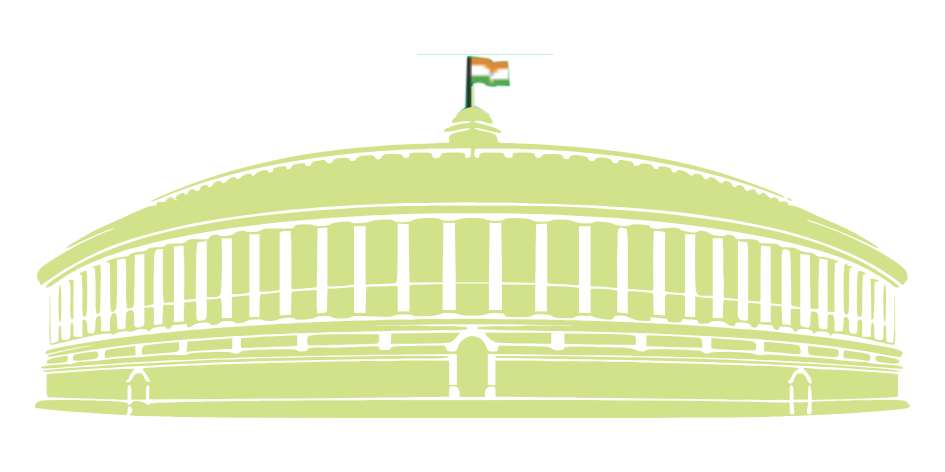Multifunctional Role of Parliament
- In the ‘Indian politico-administrative system’, the Parliament occupies a central position and has a multifunctional role. It enjoys extensive powers and performs a variety of functions towards the fulfilment of its constitutionally expected role. Its powers and functions can be classified under the following heads:

- Legislative Powers and Functions
- Financial Powers and Functions
- Executive Powers and Functions
- Judicial Powers and Functions
- Amending Powers
- Electoral Powers and Functions
- Other powers and functions.
Legislative Powers and Functions
- The Parliament legislates on all matters mentioned in the Union List and the Concurrent List.
- In the case of the Concurrent List, where the state legislatures and the Parliament have joint jurisdiction, the union law will prevail over the states unless the state law had received the earlier presidential assent. However, the Parliament can any time, enact a law adding to, amending, varying or repealing a law made by a state legislature.
- The Parliament can also pass laws on items in the State List under the following circumstances:
- If Emergency is in operation, or any state is placed under President’s Rule (Article 356), the Parliament can enact laws on items in the State List as well.
- As per Article 249, the Parliament can make laws on items in the State List if the Rajya Sabha passes a resolution by ⅔ majority of its members present and voting, that it is necessary for the Parliament to make laws on any item enumerated in the State List, in the national interest.
- As per Article 253, it can pass laws on the State List items if it is required for the implementation of international agreements or treaties with foreign powers.
- According to Article 252, if the legislatures of two or more states pass a resolution to the effect that it is desirable to have a parliamentary law on any item listed in the State List, the Parliament can make laws for those states.
Financial Powers and Functions
- No tax can be levied or collected and no expenditure can be incurred by the Executive except under the authority and with the approval of Parliament. Hence, the budget is placed before the Parliament for its approval. The enactment of the budget by the Parliament legalises the receipts and expenditure of the government for the ensuing financial year.
- The Parliament also scrutinises government spending and financial performance with the help of its financial committees.
- These include public accounts committee, estimates committee and committee on public undertakings. They bring out the cases of illegal, irregular, unauthorised, improper usage and wastage and extravagance in public expenditure.
- Therefore, the parliamentary control over the Executive in financial matters operates in two stages:
- Budgetary control, that is, control before the appropriation of grants through the enactment of the budget; and
- Post-budgetary control, that is, control after the appropriation of grants through the three financial committees.
- The budget is based on the principle of annuity, that is, the Parliament grants money to the government for one financial year.
- If the granted money is not spent by the end of the financial year, then the balance expires and returns to the Consolidated Fund of India. This practice is known as the ‘rule of lapse’. It facilitates effective financial control by the Parliament as no reserve funds can be built without its authorisation. However, the observance of this rule leads to heavy rush of expenditure towards the close of the financial year. This is popularly called as ‘March Rush’.
Executive Functions (Control over the Executive)
- In the parliamentary form of government, the executive is responsible to the legislature. Hence, the Parliament exercises control over the executive by several measures.
- By a vote of no-confidence, the Parliament can remove the Cabinet (executive) out of power. It can reject a budget proposal or any other bill brought by the Cabinet. A motion of no-confidence is passed to remove a government from office.
- The MPs (Members of Parliament) can ask questions to the ministers on their ommissions and commissions. Any lapses on the part of the government can be exposed in the Parliament.
- Adjournment Motion: Allowed only in the Lok Sabha, the chief objective of the adjournment motion is to draw the attention of the Parliament to any recent issue of urgent public interest. It is considered an extraordinary tool in Parliament as the normal business is affected.
- The Parliament appoints a Committee on Ministerial Assurances that sees whether the promises made by the ministers to the Parliament are fulfilled or not.
- Censure Motion: A censure motion is moved by the opposition party members in the House to strongly disapprove any policy of the government. It can be moved only in the Lok Sabha. Immediately after a censure motion is passed, the government has to seek the confidence of the House. Unlike in the case of the no-confidence motion, the Council of Ministers need not resign if the censure motion is passed.
- Cut Motion: A cut motion is used to oppose any demand in the financial bill brought by the government.
Judicial Powers and Functions
The judicial powers and functions of the Parliament include the following:
- It can impeach the President for the violation of the Constitution.
- It can remove the Vice-President from his office.
- It can recommend the removal of judges (including chief justice) of the Supreme Court and the high courts, chief election commissioner, comptroller and auditor general to the president.
- It can punish its members or outsiders for the breach of its privileges or its contempt.
Amending Powers
- The Parliament has the power to amend the Constitution of India. Both Houses of the Parliament have equal powers as far as amending the Constitution is concerned. Amendments will have to be passed in both the Lok Sabha and the Rajya Sabha for them to be effective.
- The Parliament can amend the Constitution in three ways:
- By simple majority;
- By special majority; and
- By special majority but with the consent of half of all the state legislatures.
- The constituent power of the Parliament is not unlimited; it is subject to the ‘basic structure’ of the Constitution. In others words, the Parliament can amend any provision of the Constitution except the ‘basic features’ of the Constitution.
- This was ruled by the Supreme Court in the Kesavananda Bharati case (1973) and reaffirmed in the Minerva Mills case (1980)
Electoral Functions
- The Parliament takes part in the election of the President and the Vice President. The electoral college that elects the President comprises of, among others, the elected members of both Houses. The President can be removed by a resolution passed by the Rajya Sabha agreed to by the Lok Sabha.
Other powers/functions of the Parliament
- Issues of national and international importance are discussed in the Parliament. The opposition plays an important role in this regard and ensures that the country is aware of alternate viewpoints.
- A Parliament is sometimes talked of as a ‘nation in miniature’.
- In a democracy, the Parliament plays the vital function of deliberating matters of importance before laws or resolutions are passed.
- The Parliament has the power to alter, decrease or increase the boundaries of states/UTs.
- The Parliament also functions as an organ of information. The ministers are bound to provide information in the Houses when demanded by the members.
Indian Polity Notes: Click Here
For Other Subject Wise Prelims Revisions: Click Here
For IAS Abhiyan NCERT Notes / Current Affairs / Test Series / Standard Notes : Click here
